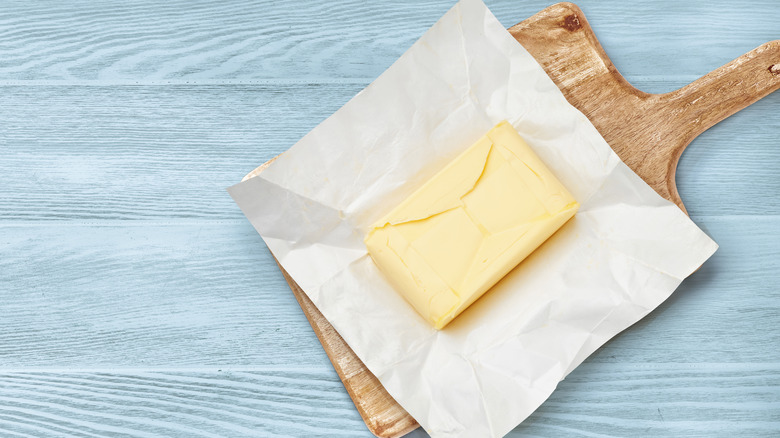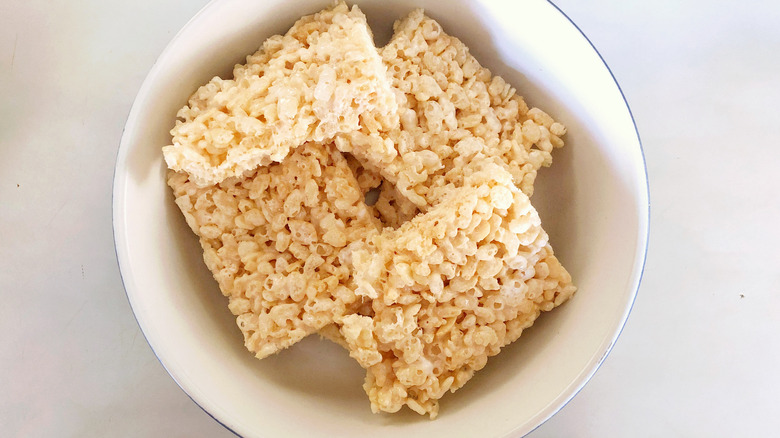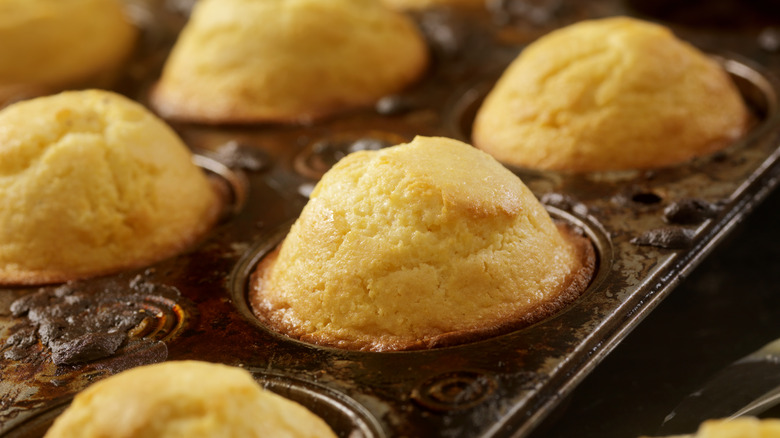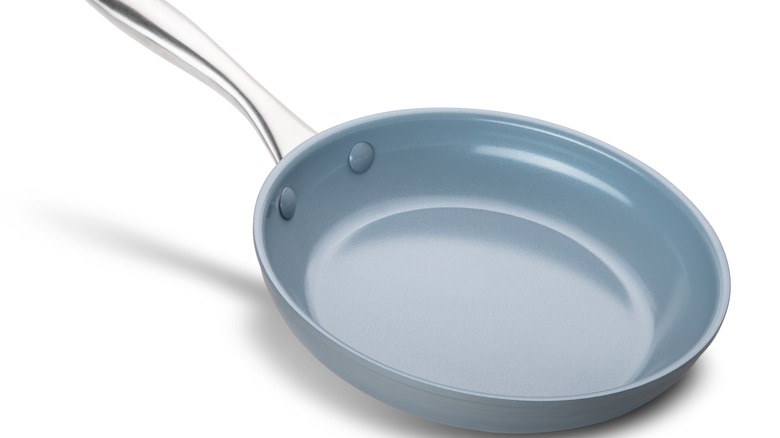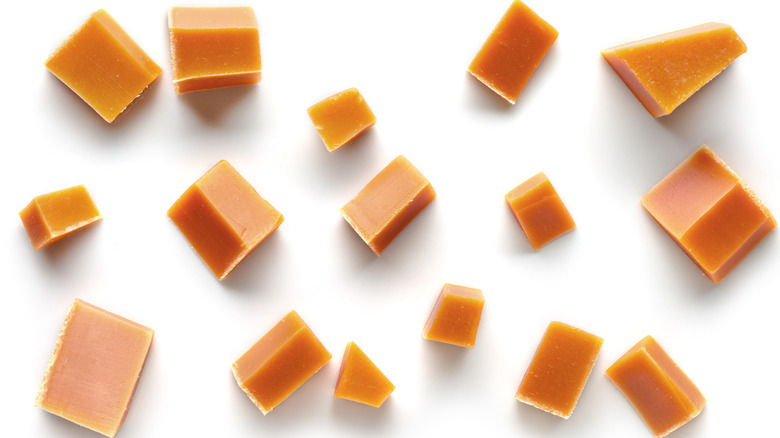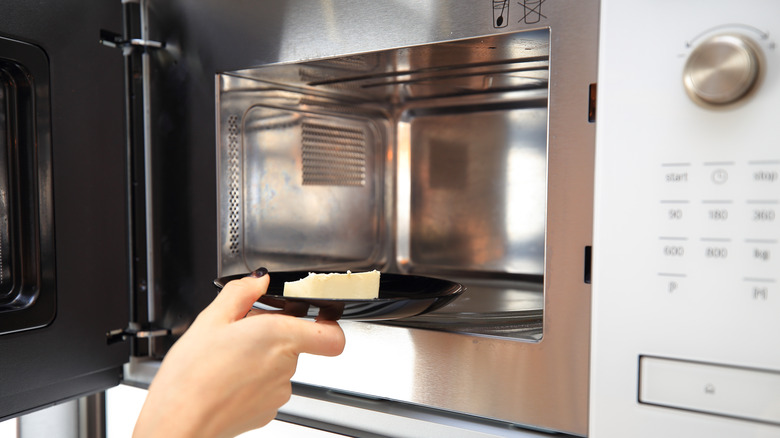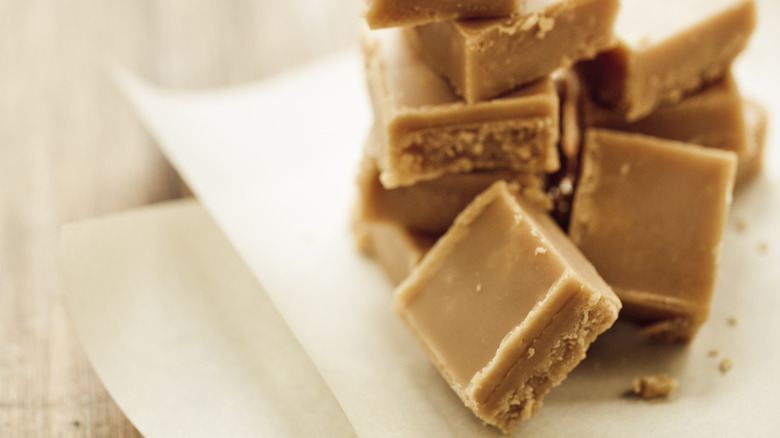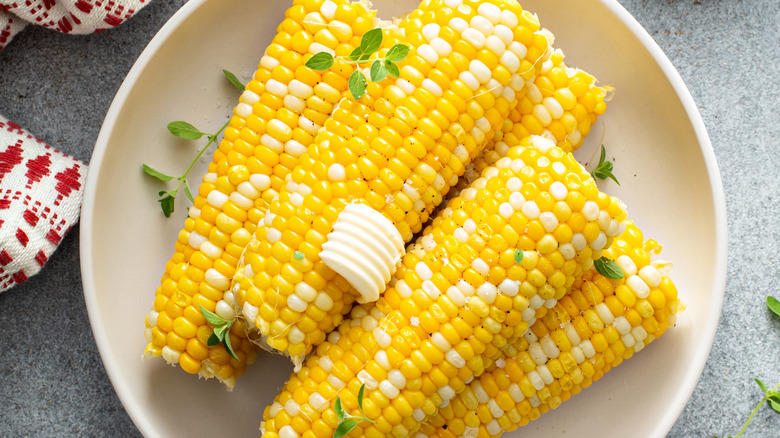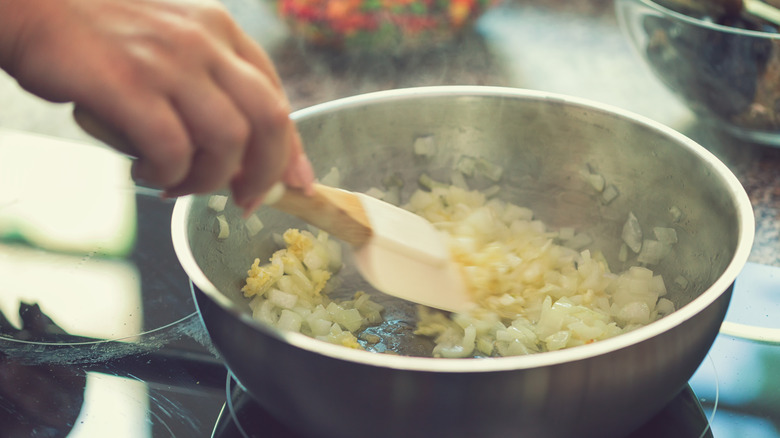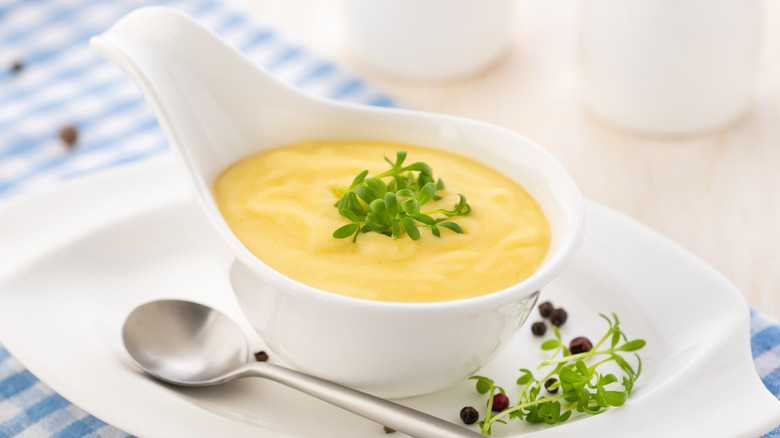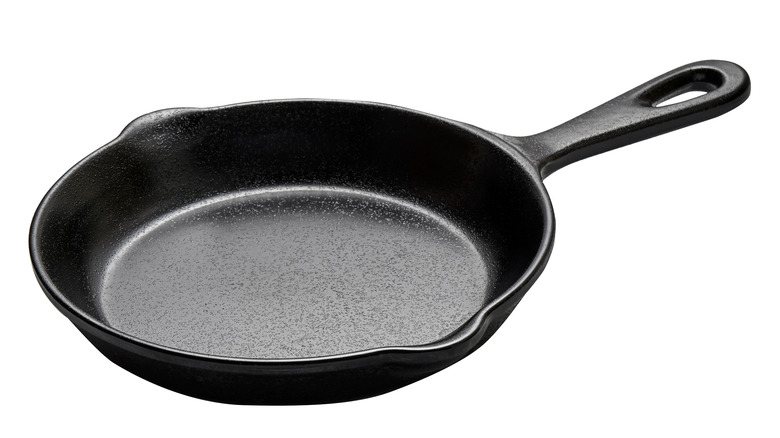11 Clever Ways To Reuse Butter Wrappers
Unless they're super bright or feature some innovative design feature, there's a good chance you don't give food wrappers more than a passing glance. After all, their main purpose is to draw you in and protect the food inside. That's all well and good, but what if we started demanding more from packaging? Specifically, what if we considered alternative uses for wrappers before tossing them away? There would be a lot less waste, for one thing. And we'd save money by repurposing things we'd already purchased instead of buying new tools.
Beyond the obvious implications, we might even find that reusing food wrappers makes our lives easier, tastier, and cleaner. That's definitely the case when it comes to reusing butter wrappers. Humble though they are, these wax paper-like sheets have a number of applications beyond simply encasing butter. Keep reading to discover 11 clever ways to reuse butter wrappers. From improving the flavor of baked goods to greasing pans more efficiently, we guarantee you'll learn something new.
For mess-free Rice Krispies Treats
Along with dirt pudding, ants on a log, and muddy buddies, Rice Krispies Treats are one of those childhood treats we still can't get enough of. Made with just three simple ingredients, Rice Krispies cereal, butter, and marshmallows, these no-bake bars conjure up images of elementary school bake sales and summer sleepovers. While most of our memories are pleasant, there is one aspect of making Rice Krispies Treats that still makes us cringe — the sticky spatula and fingers we were left with after trying to smoosh the cereal and marshmallow mixture into the pan.
Thankfully, this butter wrapper hack means gluey kitchen utensils and fingers are a thing of the past. Simply use a leftover butter wrapper to evenly spread the mixture into the baking dish. Not only are your fingers protected from the mess, but the butter residue helps repel any errant cereal pieces that try to escape.
Wrappers infuse your baked goods with buttery goodness
When you find yourself left with some butter slivers, you have a choice: either toss the wrapper or find a clever way to reuse it. Being the eco-conscious, clever people that we are, we much prefer the second option. At the same time, we can't stand trying to scrape the last vestiges of butter onto our morning toast. It's messy and not at all rewarding for all of the effort it takes.
So, rather than using an old wrapper to under-butter your toast, we propose using the leftovers to elevate your baked goods. This hack couldn't be easier. All you have to do is place the butter wrapper on top of freshly-baked muffins or sweet bread when they come out of the oven. The heat will melt the butter, allowing it to drip down and infuse your baked goods with an extra hit of buttery goodness you just have to taste to believe.
Grease pans with them
Even if all of your cookware is nonstick, there are still plenty of times when you need to add a little grease to the pan. As irritating as this extra step may be, applying some cooking spray or butter to the bottom and sides of a cake pan or cookie sheet will help your beloved treats pop off with ease.
There are about as many types of grease as there are desserts and pans: cooking spray, shortening, and canola oil are just some of the options to choose from. They all have their merits, but we prefer to keep things simple and natural by greasing pans with good old-fashioned butter. The only problem? Rubbing a stick of butter around tight corners and crevices is unwieldy and largely ineffective. Instead of fighting it, exchange your typical stick of butter for a butter wrapper. Butter wrappers are flexible and pliable, making them an excellent option for reaching all of the tricky curves in bundt pans and cupcake trays. This trick also works for skillets and griddles, so it's definitely worth keeping a couple of butter wrappers on hand.
Cut sticky foods with ease
Don't tell our dentist, but we love sinking our teeth into sticky delights like candied fruits, figs, and marshmallows. The only thing we don't love about these sweet treats? Cutting them. As soon as the knife makes the first incision, we know we're in for a back-and-forth war. No matter how much we saw or how much pressure we apply, guiding the blade through sticky foods feels as frustrating as trying to pull a toddler away from their favorite television show.
Given our past defeats, we were elated to discover a butter wrapper trick that saves us the agony of trying to segment gummy foods. And it couldn't be simpler. The only thing you need to do is rub the wrapper over the knife's surface before cutting into sticky items like Rice Krispies Treats or dried fruits. This works because the butter creates a barrier between the metal and the food, thereby eliminating stickiness. As if that weren't enough, you infuse whatever you're cutting with a little buttery flavor.
Use butter wrappers to separate hamburger patties
We know a grill master like you would never dare use pre-cut hamburger patties from the grocery store. However, on the off-chance that you have, you probably noticed that the patties were separated by thin layers of paper. You most likely also noticed how easy it was to pull the patties apart thanks to those little sheets.
Take inspiration from store-bought patties the next time you're grilling up some burgers. After forming your patties, place a butter wrapper between them as you stack. The waxy paper acts as a nonstick surface, allowing you to reach for individual patties with ease. It's also a great trick to use when freezing patties, as it prevents the meat from freezing into a massive clump. Another application of this hack is to use butter wrappers when making smashed burgers. To make perfect no-stick smashed burgers, cover a ball of ground beef with the butter wrapper before flattening the meat with a spatula or patty press. The paper barrier prevents sticking, meaning you'll get evenly-cooked burgers every time.
Keep your microwave clean
Whether you're baking chocolate chip cookies or blueberry cobbler, you find yourself in need of some melted butter. Not only does melted butter add richness and moisture to baked goods, but it helps ingredients blend together with ease. The case for liquid butter is definitely strong, but there's just one issue — melting butter in the microwave is pretty much guaranteed to make a mess.
Messes happen because the water inside the butter evaporates when it warms up. When this process starts, you'll hear popping noises and see drops of butter shoot in various directions. Rather than bite your nails or try to contain the mess with some unwieldy microwave cover, reuse a butter wrapper to prevent spattering. Placing a wrapper over the bowl you're microwaving is all you need to do to keep butter where it belongs. When using this solution, make sure you're using a wrapper made out of waxy vegetable paper, not foil. While the vegetable paper is heat-resistant and microwave-safe, foil wrappers will set off fireworks in the microwave.
Wrap up homemade candies
These days, it seems as though no one makes homemade toffee or candies. On one hand, we get it. Making candy from scratch tends to be a long and tedious process. Plus, all of the store-bought varieties make it easy (and tempting) to take the shortcut. Still, homebaked treats hold a special allure, whether you're whipping up some caramels for Christmas or taffy for a bake sale.
Instead of wrapping your precious goodies in fancy candy wrappers, consider using unmarked butter wrappers to secure your treats. Like candy wrappers, butter wrappers are slightly waxy, a characteristic that prevents candies from sticking when unwrapped. Although butter wrappers are well-suited for housing candies, there are a few things you need to do before using them. First, it's essential to wipe any traces of butter from the paper. Next, measure and cut the wrappers into 5-inch by 5-inch squares. Depending on the size of the wrapper, you should be able to get one, if not two, candy wrappers from each piece.
Butter corn on the cob
For as long as people have been eating corn on the cob, they've struggled when it comes to dressing it. Indeed, the round shape and bumpy surface make even application of your desired topping nearly impossible. While it's true that some enterprising people have developed corn-specific butter spreaders, there's no need to shell out for a new kitchen tool you're only going to use a few months out of the year.
Rather than spend your hard-earned money on a piece of flimsy plastic that's just going to sit in your kitchen drawer, use a leftover butter wrapper to spread butter over every nook and cranny. Thanks to their pliability, butter wrappers are able to reach each and every kernel, ensuring that your ear is completely covered in delicious buttery flavoring. While we're big proponents of this idea, there is one downside. Each wrapper can butter a single ear of corn. Not ideal when you've got a full house. An easy solution is to store leftover wrappers in the refrigerator or freezer so you have enough for everyone come party time.
Sauté onions to perfection
When cooking with onions, every recipe is different. Sometimes, like when making pizza or French onion soup, you want your alliums dark brown, caramelized, and melt-in-your-mouth soft. Other times, like when making a burger topping, you want lightly sautéed onions that still have a yellowish tint to them. Achieving the right texture and color without overcooking (or worse, burning) them requires a pretty high culinary IQ.
At least that used to be the case. With this butter wrapper hack, you don't have to guard the stove or keep your hand on the heat dial anymore. To lightly sauté onions without fear, envelope them in a butter wrapper before placing them into the pan. Keep the heat low and leave the lid off of the pan. Cook for several minutes, checking periodically to ensure proper cooking. Not only does this trick prevent onions from burning, but it also stops them from sticking to the pan. Talk about a win-win.
Preserve butter-based sauces
Brunch would be nothing without sauces like hollandaise and bearnaise. In addition to adding a pop of color to your plate, these butter-based sauces bring all kinds of flavor to eggs, toast, and avocados. Unfortunately, for all of the benefits they bring, these sauces can also be a pain to work with. They can break or curdle at the drop of a hat, dooming your midmorning meal to mediocrity.
While breaking and curdling are two often-discussed problems, hardly anyone mentions the issue of sauces developing skin. As nasty as it sounds, butter-based sauces have a tendency to develop a thin film as soon as they start to cool down. Keeping them on the stove is one solution, but that's not always practical, especially if you've got several dishes cooking at once. An easier solution is to cover sauces with leftover butter wrappers (bonus points if there's a little butter left on the sheet). By shielding precious sauces from the air and adding a bit of fat, you can put an end to unsightly skins once and for all.
Season cast iron pans
There are a lot of things to love about cast iron pans. They're heavy-duty, have excellent heat retention, and can be used to cook everything from cornbread to cobbler. While these culinary heavy hitters have a lot going for them, they do require a significant amount of upkeep to keep them in prime condition. More specifically, you've got to season your cast iron pan about once a month (depending on how much you use it).
Although the term is the same, seasoning a cast iron pan has nothing to do with adding a pinch of salt or a dash of cinnamon. Rather, it refers to the process of coating the pan's surface with a thin layer of fat. When the fat heats up, it bonds to the metal in the pan, creating a protective skin. Not only does this skin help your pan last for years, but it also conveys nonstick properties. A lot of chefs recommend rubbing an oil-dampened towel over the pan's surface to season it, but there's no need to waste coconut or vegetable oil. Rather, you can use a leftover butter wrapper to coat the inside of the pan with some much-needed fat.
Static Media owns and operates Tasting Table and The Daily Meal.
